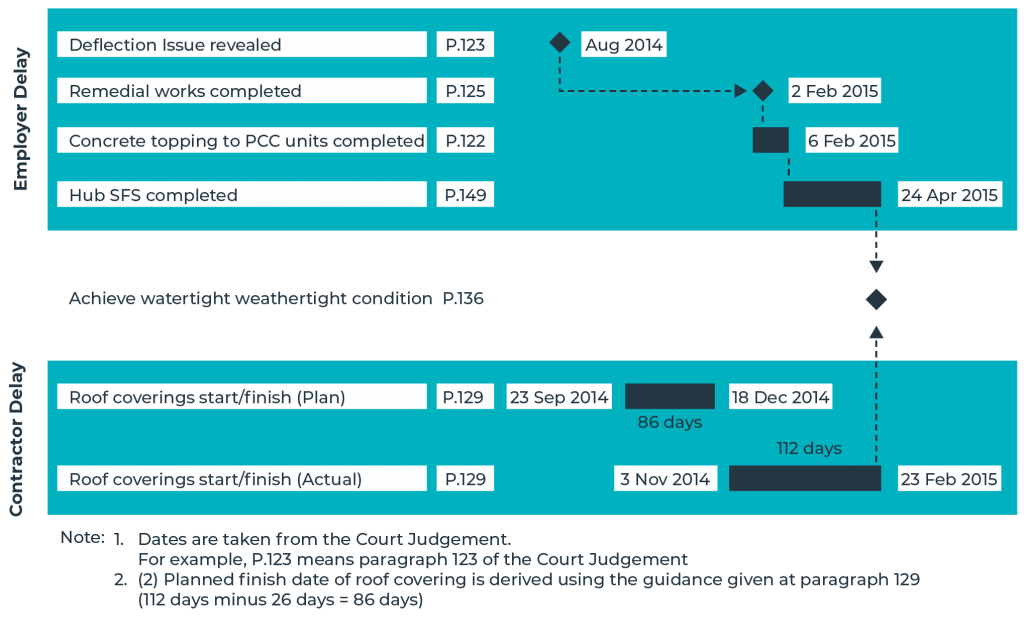Concurrent Delays
2nd March 2023
The term ‘concurrent delays’ was defined by Mr. John Marrin QC as quoted below.[1] This definition was later approved by the English court.[2]
“The expression ‘concurrent delay’ is used to denote a period of project overrun which is caused by two or more effective causes of delay which are of approximately equal causative potency”.
The cause or an event is ‘effective’ if it impacts the project completion date. In circumstances, where Event A is already delaying the project completion date, can a subsequent Event B, which is of equal causative potency as that of Event A and that would have delayed the project completion had Event A not arisen, be considered an effective cause of delay and therefore a concurrent delay situation?

The issue of concurrent delay was discussed in English courts in Henry Boot,[3] Royal Brompton,[4] Walter Lilly,[5] Saga Cruise[6] and Adyard Abu Dhabi.[7]
In Saga Cruise,[8] the project overran from 2 to 16 March due to the contractor’s delay. The employer levied delay damages for the period of project overrun. The contractor submitted that various employer delay events were concurrent with its delays with the aim of avoiding or reducing the delay damages imposed. The Judge Sara Cockerill did not agree that the employer’s delay events, which would have independently caused project overrun between 2 and 11 March, was concurrent with the contractor’s delay. The underline reason given by the Judge was that the two delays did not ‘cancel out’ each other.[9] In other words, the two delays did not cause the same period of project overrun. Generally, the Saga Cruise approach has been the approach used to understand the meaning of concurrent delays in England.
However, on 17 October 2022, England’s Technology and Construction Court (TCC) issued a judgment that appears to contradict the Saga Cruise approach. In Thomas Barnes & Sons Plc (in Administration) v Blackburn with Darwen Borough Council, [10] TBS was the Contractor and the claimant; and Blackburn was the Employer and the defendant. One of the disputes related to a concurrent delay disagreement.
The project was for the construction of a bus station that was largely divided into two areas: first ‘the hub’ that provided office space on the ground floor and mezzanine first floor; and second ‘the concourse’ area that provided waiting space and access to buses. The building structure of the bus station was to be constructed using a structural steel frame. The structural steel framework forming the walls of the hub and the concourse were to be built using the steel frame sections (SFS). As in most construction projects of this nature, the critical path of the bus station works ran through: foundation to walls; walls to roof; achieve watertight and weathertight conditions; start internal finishes work; and so on.
The Employer was mainly responsible for the design of the project works. When the structural steelwork was erected and complete, a deflection problem to the structural steel walls was patent in the hub and concourse areas (‘Deflection Issue’). Both the hub and concourse were to achieve a watertight and weathertight condition to allow the internal finishes to commence. To achieve watertight and weathertight condition, both the structural steel walls and roof had first to be completed. Though the Deflection Issue occurred in both the hub and the concourse, the Contractor’s delay expert considered this issue critical for the hub walls only for delay analysis purposes (P.38 & 105) i.e. the Employer’s delay.
Therefore, in the Judgement, the issue of concurrent delay revolves around two delays:
- Employer Delay: delay to the hub walls caused by the Deflection Issue; and
- Contractor Delay: delays to the roof caused by the subcontractor or Contractor’s internal issues.
Timeline of both delays is shown below:

Employer Delay: The Employer’s delay expert (Mr. Gunton) was of the view that the Contractor extended the period of the Employer Delay by 12 days from 8 to 26 January 2015 by replying late to the designer. However, the Contractor’s delay expert (Mr. Hudson) was of the view that the 12 days was needed for the mobilisation of the subcontractor who did remedial works therefore it was not a delay. As per the Judge, even if it was for the subcontractor’s mobilisation, it should have been four days at maximum and not 12 days (P.126 & 127). In other words, the Contractor caused eight days delay during the period of the Employer Delay. This means Hub SFS should have completed eight days earlier than 24 April 2015 or say mid of April 2015. In summary, the Deflection Issue prevented the internal finishes from starting between August 2014 and mid of April 2015 and thus caused the project overrun.
Contractor Delay: The Judge found that the roof coverings should have started on 23 September 2014, but it started on 3 November 2014, and the roof was completed on 23 February 2015 taking additional 26 days to complete if compared with original as-planned duration (P.129). In summary, and taking a broad-brush approach, the Contractor’s delays would have independently prevented the internal finishes from starting between 23 September 2014 and 23 February 2015 at the maximum because this is the actual duration within which the roof covering was being built and thus would have caused the project overrun in any event.
In the period between August 2014 and April 2015 (the ‘Timeframe’), and to achieve a watertight/weathertight condition, it is important to note that approximately two and half months of work was required to be carried out:
- on wall after the resolution of the Deflection Issue (2 Feb 2015 to mid of April 2015); and
- on roof coverings as per original plan (23 September 2014 to 18 December 2014).
In summary, and in the Timeframe, both activities regarding the wall and roof coverings:
- required approximately the same duration to execute the works; and
- completion of both was critical to achieve watertight/weathertight condition from a common sense perspective.
The Contractor’s delay expert considered the roof coverings as non-critical in the Timeframe because completion of the walls took significantly longer than the roof coverings. In other words, the Contractor knowing that the completion of the walls was being delayed due to the Deflection Issue, it delayed the roof coverings – a form of pacing delay. The Judge’s response to this approach was:
“If by this he [Mr. Hudson] meant to suggest that the roof covering could have been progressed but they were non-critical and could have been performed in a more leisurely manner as a result, this seems to me to ignore the fundamental fact that throughout the crucial period from October 2014 through to January 2015 the claimant [the Contractor] could not have known how long the remedial works to the hub steelworks would take and could not therefore reasonably have proceeded on the basis that there was no need to worry about the roof covering until the hub steel deflection issue was completely resolved.” (P.133)
In the author’s opinion, while it might be true that the Contractor did not precisely know, at the time, when the Deflection Issue would be resolved or when the successor activities that were dependent on the Deflection Issue (such as concrete topping to PCC units and completion of Hub SFS elements) would be completed. However, the deflection to structural steel was a serious issue which would have involved investigation, design reconsideration, rework, remedial work and the execution of the successor activities as well. In the author’s experience, the Contractor should be allowed at its own risk to pace their works in such circumstances if they wish to do so. Secondly, the planned start of the roof coverings was one month late (and not before) the date when the Deflection Issue became apparent.
In any event, the facts that unraveled during the Timeframe suggest that the Deflection Issue was the effective cause of delay at least until mid-April 2015, whereas the roof coverings had ceased to impact significantly earlier than mid-April 2015. Therefore, in the Timeframe, and in circumstances where the Deflection Issue arose first and continued significantly longer even after the roof coverings had been installed, it is difficult to understand the criticality of roof coverings and the concurrent delay situation as explained by the Judge:
“In his cross-examination, Mr. Hudson accepted that the internal works could not progress until the roof coverings were on and the working area was watertight and weathertight, while emphasising that the same applied to the external walls. His explanation in cross-examination for not taking the roof coverings into account was as follows: “Yes, when I did look at the roof coverings and when they were completed. So even if the roof is done, you can’t start any finishes because of the SFS, therefore, the roof coverings were not critical”.
This was a very neat explanation of his approach, which was to work backwards from the as-built critical path and, because the hub SFS were finished after the roof coverings, to treat the hub SFS as on the critical path and to discount the roof coverings as event being on the critical path from the outset.” (P.136 & 137)
“In my judgement, this is a case where these causes were concurrent over the period of delay caused by the roof coverings. That is because completion of the remedial works to the hub structural steelwork was essential to allow the concrete topping to be poured and the hub SFS to be installed, without which the hub finishes could not be meaningfully started, but completion of the roof coverings was also essential for the hub finishes to be meaningfully started as well. It is not enough for the claimant to say that the works to the roof coverings were irrelevant from a delay perspective because the specification and execution of the remedial works to the hub structural steelwork were continuing both before and after that period of delay. Conversely, it is not enough for the defendant to say that the remedial works to the hub structural steelwork were irrelevant from a delay perspective because the roof coverings were on the critical path. The plain fact is that both of the works items were on the critical path as regards the hub finishes, and both were causing delay over the same period.” (P.140)
In the author’s understanding, the roof coverings delay did not cancel out, as explained in in Saga Cruise, the delays arising from the Deflection Issue. In addition, the roof coverings delay did not fulfil the requirements of definition of ‘concurrent delay’ given by Mr. John Marrin QC due to the following reasons:
- the effect of roof coverings delay did not arise closely with the Deflection Issue even if planned start date of roof covering is considered; and
- the roof covering delays ceased to affect (or cause delay) significantly earlier than the Deflection Issue did, therefore the roof covering delay was neither an ‘effective cause’ nor a cause of ‘equal causative potency’ as that of the Deflection Issue.
It is unknown if this decision will be appealed, but in the author’s opinion, it is likely not to be due to the administration of the claimant, which is unfortunate. Moreover, this decision has increased the uncertainty relating to the meaning of concurrent delays in England.
[1] John Marrin QC, SCL paper entitled “Concurrent Delay”, 2003.
[2] Adyard Abu Dhabi v SD Marine Services [2011] EWHC 848 (Comm); [2011] B.L.R. 384; 136 Con. L.R. 190.
[3] Henry Boot Construction (UK) Ltd v Malmaison Hotel (Manchester) Ltd [1999] 70 Con. L.R. 32.
[4] Royal Brompton Hospital NHS Trust v Frederick A Hammond & Ors [2000] EWHC Technology 39.
[5] Walter Lilly & Company Limited v Giles Patrick Cyril Mackay, DMW Developments Limited [2012] EWHC 1773.
[6] Saga Cruises BDF Ltd v Fincantieri SPA [2016] EWHC 1875 (Comm).
[7] Adyard Abu Dhabi v SD Marine Services [2011] EWHC 848 (Comm).
[8] Saga Cruises BDF Ltd v Fincantieri SPA [2016] EWHC 1875 (Comm).
[9] Ibid. Paragraphs 309 to 313.
[10] Thomas Barnes & Sons Plc v Blackburn with Darwen Borough Council [2022] EWHC 2598 (TCC).
This publication presents the views, thoughts or opinions of the author and not necessarily those of HKA. Whilst we take every care to ensure the accuracy of this information at the time of publication, the content is not intended to deal with all aspects of the subject referred to, should not be relied upon and does not constitute advice of any kind. This publication is protected by copyright © 2024 HKA Global Ltd.




